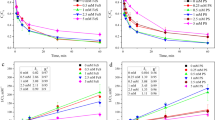Abstract
Catalytic wet peroxide oxidation (CWPO) is a novel, alternative technology to conventional disinfection methods that are widely used to control microbial parameters in drinking water. To assess its effectiveness, new studies revealing the kinetics of MS2 coliphage inactivation by CWPO technology are required. This investigation therefore aimed to perform mathematical modelling of MS2 inactivation through CWPO technology activated by an Al/Fe-pillared clay catalyst (Al/Fe-PILC) in the presence of a synthetic surrogate of dissolved natural organic matter. The inactivation constant was obtained from two different statistical approaches, and the experimental data were better fitted to the pseudo-first-order Chick-Watson model in which the inactivation rate is constant. For this model, the maximum inactivation rate was k = 0.1648 min−1, which was achieved in the MS2-3 catalytic test using an initial mass ratio of peroxide to active iron (Feact) of 1.2 mg H2O2/mg Feact. To estimate the inactivation rate due to reactive oxygen species (ROS), we supposed that the inactivation constant depends on both ROS and Feact. In this case, the maximum inactivation rate due to ROS was kr = 2.4 × 10−9 min−1 (using 1.17 mg H2O2/mg Feact), which was achieved in the MS2-10 trial; both cases led to the conclusion that the optimal initial ratio of peroxide to active Fe in the catalyst in CWPO activated by Al/Fe-PILC was close to 1.2 mg H2O2/mg Feact. These kinetic studies showed that rapid inactivation takes place very early in the reaction, followed by slow inactivation during the remaining period of the recorded reaction time. This research revealed the strong potential of CWPO technology to improve microbiological parameters in drinking water due to the high catalytic performance in the heterogeneous Fenton reaction displayed by Fe sites incorporated in the Al/Fe-PILCs.

Similar content being viewed by others
References
Bokare AD, Choi W (2014) Review of iron-free Fenton-like systems for activating H2O2 in advanced oxidation processes. J Hazard Mater 275:121–135. https://doi.org/10.1016/j.jhazmat.2014.04.054
Dalrymple OK, Stefanakos E, Trotz MA, Goswami DY (2010) A review of the mechanisms and modelling of photocatalytic disinfection. Appl Catal B Environ 98:27–38. https://doi.org/10.1016/j.apcatb.2010.05.001
Francis RA, Small MJ, Van Briesen JM (2009) Multivariate distributions of disinfection by-products in chlorinated drinking water. Water Res 43:3453–3468. https://doi.org/10.1016/j.watres.2009.05.008
Galeano LA, Gil A, Vicente MA (2010) Effect of the atomic active metal ratio in Al/Fe-, Al/Cu- and Al/(Fe–Cu)-intercalating solutions on the physicochemical properties and catalytic activity of pillared clays in the CWPO of methyl orange. Appl Catal B Environ 100:271–281. https://doi.org/10.1016/j.apcatb.2010.08.003
Galeano LA, Vicente MA, Gil A (2014) Catalytic degradation of organic pollutants in aqueous streams by mixed Al/M-pillared clays (M = Fe, Cu, Mn). Catal Rev 56:239–287. https://doi.org/10.1080/01614940.2014.904182
Galeano LA, Guerrero-Flórez M, Sánchez CA, Gil A, Vicente MÁ (2017) Disinfection by Chemical Oxidation Methods. In: Gil A, Galeano L, Vicente M (eds) Applications of advanced oxidation processes (AOPs) in drinking water treatment. The Handbook of Environmental Chemistry, vol 67. Springer, Cham
García AM, Torres-Palma RA, Galeano LA, Vicente MÁ, Gil A (2017) Separation and characterization of NOM intermediates along AOP oxidation. In: Gil A, Galeano LA, Vicente MÁ (eds) Applications of Advanced Oxidation Processes (AOPs) in Drinking Water Treatment. The Handbook of Environmental Chemistry, vol 67. Springer, Cham
Giannakis S (2017) Analogies and differences among bacterial and viral disinfection by the photo-Fenton process at neutral pH: a mini review. Environ Sci Pollut Res Int 25:27676–27692. https://doi.org/10.1007/s11356-017-0926-x
Giannakis S, Liu S, Carratalà A, Rtimi S, Bensimon M, Pulgarin C (2017) Effect of Fe(II)/Fe(III) species, pH, irradiance and bacterial presence on viral inactivation in wastewater by photo-Fenton process: kinetic modelling and mechanistic interpretation. Appl Catal B Environ 204:156–166. https://doi.org/10.1016/j.apcatb.2016.11.034
He J, Yang X, Men B, Wang D (2016) Interfacial mechanisms of heterogeneous Fenton reactions catalyzed by iron-based materials: a review. J Environ Sci 39:97–109. https://doi.org/10.1016/j.jes.2015.12.003
INCA (2019) National report on water quality for human consumption. IOP Publishing Physics Web https://www.minsalud.gov.co/sites/rid/Lists/BibliotecaDigital/RIDE/VS/PP/SA/calidad-del-agua-inca-2017.pdf. Accessed 14 June 2019. (in Spanish)
Jofre J, Lucena F, Blanch A, Muniesa M (2016) Coliphages as model organisms in the characterization and management of water resources. Water 8:1–21. https://doi.org/10.3390/w8050199
Kim JY, Lee C, Sedlak DL, Yoon J, Nelson KL (2010) Inactivation of MS2 coliphage by Fenton’s reagent. Water Res 44:2647–2653. https://doi.org/10.1016/j.watres.2010.01.025
Koizumi Y, Taya M (2002) Kinetic evaluation of biocidal activity of titanium dioxide against phage MS2 considering interaction between the phage and photocatalyst particles. Biochem Eng J 12:107–116. https://doi.org/10.1016/S1369-703X(02)00046-3
Misstear D, Gil LW (2012) The inactivation of phages MS2, φX174 and PR772 using UV and solar photocatalysis. J Photochem Photobiol B 107:1–8. https://doi.org/10.1016/j.jphotobiol.2011.10.012
Muñoz HJ, Vallejo C, Blanco C, Gil A, Vicente MA, Ramírez JH, Galeano LA (2018) 10 kg scaled-up preparation of Al/Fe-pillared clay CWPO catalysts from concentrated precursors. Green Chem 20:5196–5208. https://doi.org/10.1039/C8GC02445F
Neyens E, Baeyens J (2003) A review of classic Fenton’s peroxidation as an advanced oxidation technique. J Hazard Mater 98:33–50. https://doi.org/10.1016/S0304-3894(02)00282-0
Nieto-Juarez J, Kohn T (2013) Virus removal and inactivation by iron (hydr)oxide-mediated Fenton-like processes under sunlight and in the dark. Photochem Photobiol Sci 12:1596–1605. https://doi.org/10.1039/c3pp25314g
Nieto-Juarez J, Pierzchla K, Sienkiewicz A, Kohn T (2010) Inactivation of MS2 coliphage in Fenton and Fenton-like systems: role of transition metals, hydrogen peroxide and sunlight. Environ Sci Technol 44:3351–3356. https://doi.org/10.1021/es903739f
Pérez-Méndez A, Chandler JC, Bisha B, Goodidge LD (2014) Evaluation of an anion Exchange resin-based method for concentration of F-RNA coliphages (enteric virus indicators) from water samples. J Virol Methods 204:109–115. https://doi.org/10.1016/j.jviromet.2014.03.024
Ramírez JH, Galeano LA (2019) Natural organic matter removal by heterogeneous catalytic wet peroxide oxidation (CWPO). In: Gil A, Galeano L, Vicente M (eds) Applications of Advanced Oxidation Processes (AOPs) in Drinking Water Treatment, vol 67. Springer, Cham, pp 69–98
Ramírez JH, Galeano LA, Pinchao G, Bedoya RA, Hidalgo A (2018) Optimized CWPO phenol oxidation in CSTR reactor catalyzed by Al/Fe-PILC from concentrated precursors at circumneutral pH. J Environ Chem Eng 6:2429–2441. https://doi.org/10.1016/j.jece.2018.02.024
Rodríguez-Chueca J, Ormad-Melero MP, Mosteo-Abad R, Esteban-Finol J, Ovelleiro-Narvion LO (2015) Inactivation of Escherichia coli in fresh water with advanced oxidation processes based on the combination of O3, H2O2, and TiO2. Kinetic modeling. Environ Sci Pollut Res 22:10280–10290. https://doi.org/10.1007/s11356-015-4222-3
Sanabria NR, Ávila P, Yates M, Rasmussen SB, Molina R, Moreno S (2010) Mechanical and textural properties of extruded materials manufactured with Al-Fe and Al-Ce-Fe pillared bentonites. Appl Clay Sci 47:283–289. https://doi.org/10.1016/j.clay.2009.11.029
Singh J, Knapp HV, Demissie M (2005) Hydrologic modeling of the Iroquois River watershed using HSPF and SWAT. J Am Water Resour Assoc 41:343–360. https://doi.org/10.1111/j.1752-1688.2005.tb03740.x
Sun CX, Kitajima M, Gin KY (2016) Sunlight inactivation of somatic coliphage in the presence of natural organic matter. Sci Total Environ 541:1–7. https://doi.org/10.1016/j.scitotenv.2015.08.136
Wang N, Zheng T, Zhang G, Wang P (2016) A review on Fenton-like processes for organic wastewater treatment. J Environ Chem Eng 4:762–787. https://doi.org/10.1016/j.jece.2015.12.016
Wigginton KR, Kohn T (2012) Virus disinfection mechanisms: the role of virus composition, structure, and function. Curr Opin Virol 2:84–89. https://doi.org/10.1016/j.coviro.2011.11.003
Yang Y, Zhang H, Yan Y (2019) Preparation of novel iron-loaded microfibers entrapped carbon-nanotube composites for catalytic wet peroxide oxidation of m-cresol in a fixed bed reactor. Sep Purif Technol 212:405–415. https://doi.org/10.1016/j.seppur.2018.11.050
Acknowledgements
The authors would like to thank the Microbiología de Aguas Relacionada con la Salud (Microbiology of Water Related to Health) (MARS) research group of the Biology Department at the University of Barcelona (Spain) for providing training in environmental virology techniques and facilitating the coliform strains MS2 and its host bacterium Salmonella typhimurium WG49.
Funding
Financial support for this research was provided by the Nariño Drinking Water Project-SGR (BPIN 2014000100020), from the CTeI Fund of Sistema General de Regalías-Colombia.
Author information
Authors and Affiliations
Corresponding author
Additional information
Responsible editor: Vítor Pais Vilar
Publisher’s note
Springer Nature remains neutral with regard to jurisdictional claims in published maps and institutional affiliations.
Rights and permissions
About this article
Cite this article
Ibarguen-Mondragon, E., Revelo-Romo, D., Hidalgo, A. et al. Mathematical modelling of MS2 virus inactivation by Al/Fe-PILC-activated catalytic wet peroxide oxidation (CWPO). Environ Sci Pollut Res 27, 19836–19844 (2020). https://doi.org/10.1007/s11356-020-08365-4
Received:
Accepted:
Published:
Issue Date:
DOI: https://doi.org/10.1007/s11356-020-08365-4




